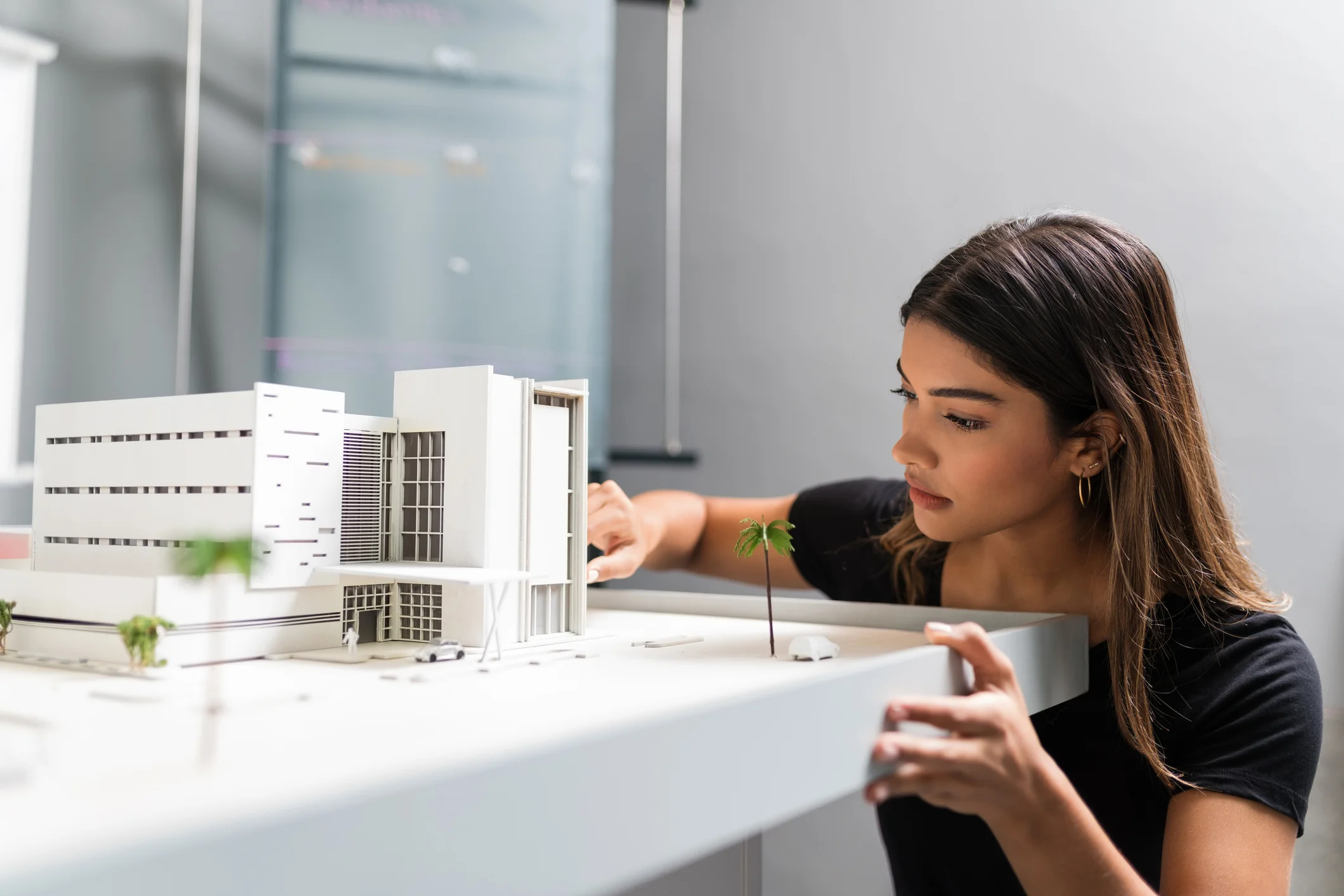Overview
Built for design
Architectural technologists are the experts that translate a modern architect’s vision into reality. With innovative techniques and digital tools, they bridge the gap between architectural aesthetics and practicality, taking into consideration safety, sustainability, functionality and efficiency.
As digitisation and regulations such as the Building Safety Act reshape this field, there’s a growing demand for technical expertise and knowledge. On UCEM’s part-time, online BSc (Hons) Architectural Design Technology programme, you’ll explore the dynamic intersection between design, technology and construction and become a valuable contributor to the evolving landscape of architecture and built environment sustainability.

About this degree
Programme details
This part-time online programme is a gateway to a professional career as an architectural technologist, or design-related work within the construction industry. You’ll explore in detail the stages of the briefing, design and construction, and learn to contextualise law, manage information and consider the resulting impact on sustainability throughout the process. You’ll also be exposed to new technological innovations, including building information modelling (BIM), and have the opportunity to apply these to your own projects and design proposals.
Course accreditations
The programme has been designed to align with the Chartered Institute of Architectural Technologists (CIAT) standards and UCEM plans to seek CIAT accreditation.
Structure
Modules you will study
If you choose the part-time route, you will study 18 modules across 4.5 years.
Autumn
Introduction to the Built Environment 1
Appreciate how legal, political and social issues shape our sector and its role in the economy. Understand the project lifecycle and the RIBA Plan of Work. Identify the industry’s stakeholders and professions and your chosen profession’s key responsibilities in meeting client objectives.
Introduction to Sustainability
Explore the causes of climate change and the challenges of sustainable development, with particular focus on the construction and property sector. Examine the relationship between property and the environment along with the criteria used to measure sustainability in relation to finished construction projects.
Professional and Business Practice
Gain an understanding of the organisational structures within the sector. Appreciate the role of business planning and the accounting concepts that support decision making. Consider the importance and benefits of client management, professionalism, ethical practice and diversity in the workforce.
Establish a foundation knowledge of buildings, the environment and technology, also considering them from a sustainability perspective. Develop your communication skills and construction literacy with real-world examples of construction projects, including traditional masonry and roof construction.
Introduction to Regulatory and Built Environment Law
Dive into the legal and regulatory requirements that relate to the construction and property sector, along with the legal environment in the context of planning, design and occupation and health and safety as it relates to both design and construction activity.
Design Development and Production Coordination
Develop a holistic understanding of the architectural design process against the backdrop of compliance with industry standards for effective coordination and communication. Combine your manual and digital skills through the use of software, media and information technology.
The relationship between a building’s design, environment and occupants is complex. With the overarching theme of human comfort, break down the individual factors – heat, air moisture sound and light within these aspects of a building, and how each of these factors affect one another, in the context of domestic or office environments.
Retrofit is a crucial function for keeping existing buildings in use and fit for purpose. Explore the range of different retrofitting project types and associated issues while developing the knowledge and skills required to appraise and develop retrofit and refurbishment solutions.
Explore the core competencies of building control you’ll need to become a member of relevant professional bodies. Examine requirements for site inspections of building work, with reference to legislation like the Building Safety Act 2022, and apply these standards to different scenarios.
Building Pathology and Conservation Principles
Build an understanding of building pathology – the study of building decay, defects and performance failure. Develop your ability to effectively diagnose and evaluate a range of common building defects through inspection, testing, survey and analysis.
Design and Environmental Science
The relationship between a building’s design, environment and occupants is complex. With the overarching theme of human comfort, break down the individual factors – heat, air moisture sound and light within these aspects of a building, and how each of these factors affect one another, in the context of domestic or office environments.
Technology and Design 1 – Contemporary Domestic
Use sustainable and environmental design strategies to create holistic and technically designed solutions that are responsive to client’s needs. Generate design solutions to the level of detail in Stage 4 of RIBA Plan of Works using architectural modelling software.
Modelling Information Management; Theory and Practice
Learn the theory and practical application of information management standards, protocols and responsibilities, and showcase your expertise by operating in a common data environment and applying information exchange protocols to support collaborative working.
Technology and Design 2 – Data Informed Design for Commercial Buildings
Create a holistic, responsive solution to client and design brief requirements that is predicated on data. Through the use of digital design tools, this will culminate in a final design proposal evolving from 3D computer-generated concepts informed by energy performance simulation and analysis.
Consolidate your knowledge and skills by working in multi-disciplinary groups in a project scenario. This project will help you identify the procedures required for the adaptation and refurbishment of a building based on a client’s brief.
Technology and Design 3 – Design for Manufacture and Assembly
Utilise 2D and 3D design tools to prepare a proposal for manufacture and assembly. By selecting either a building component or a volumetric element and using modelling, further develop your understanding of the design and manufacturing process and knowledge of logistics, planning and quality.
Project Management in the Built Environment
Gain an understanding of the project management services provided by a building surveyor, including management, procurement, planning and programming, risk management and conflict avoidance.
Develop independent design-based research skills and demonstrate your ability to apply theoretical concepts to propose a holistic or localised design solution against the backdrop of a defined physical, cultural, social or economic project context.
The module structure above is indicative for those beginning their studies in the autumn. For further information about programme content, or to see how modules are structured for those starting in spring, you can view the full programme specification which sets out aims, intended learning outcomes and assessment methods.
If you are looking to study this programme on the full-time route, the module table will vary. You can find more information on this by getting in touch with our knowledgeable Admissions Team.
For further information on modules view our module descriptors. Please note that modules are subject to change.
Online learning
The future of study
Flexible study
Balance your study, work and home commitments, all while working towards your career goals
e-Library access
Full access to a comprehensive and valuable e-library with a wealth of resources to support your studies
Interactive
Study using a diverse range of interactive, modern and dynamic learning resources
Expert-led
Learning activities that have been designed by UCEM tutors and subject matter experts
Stay connected
Learn alongside a diverse community of students from all over the world
Time commitment and study breakdown
Studying two modules per semester requires an expected time commitment of 15-20 hours per week. If you study only one module per semester, the weekly time commitment will be less, depending on the module’s credit size. Most modules are typically 20 credits.
Directed study time (%)
Self-directed study time (%)
Assessment study time (%)
Careers
Where can it take you?
The skills and expertise this course fosters are in high demand in the industry. Students that complete this programme may apply for Associate membership (ACIAT) with CIAT or CIAT Affiliate Status depending on the nature of their employment (see the CIAT website for more details). As a graduate from this programme, you will greatly increase your employability and/or ability to progress your career in the built environment. You could take up or progress to a professional position in many roles, including:
- Architectural Technologist
- BIM Technician
- Construction Site Technician
- Design and Build Co-ordinator
Memberships
The programme has been designed to align with the Chartered Institute of Architectural Technologists (CIAT) standards and UCEM plans to seek CIAT accreditation. Students can apply for student membership of CIAT through their website.
Earning potential

25,000-70,000*
![]()
Applications
Ready to apply?
Questions?
Get in touch
Admissions Team
UK (Free): 0800 019 9697 (Option 1)
International: +44 (0)118 921 4696 (Option 1)
























